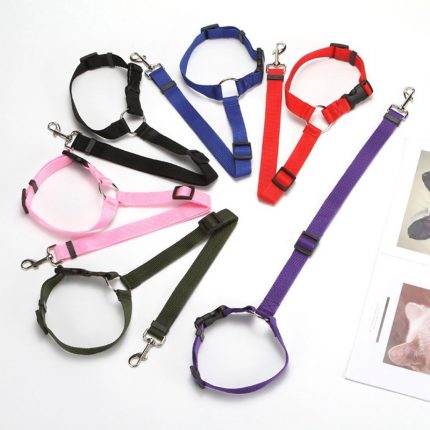Dogs have long been considered man’s best friend, offering unwavering loyalty, companionship, and unconditional love. Their ability to understand human emotions and provide comfort is unparalleled. However, there are instances when dogs may exhibit behavior that seems contrary to their natural inclination to be close to their owners. One such behavior is Why Do Dogs Push You Away?
This puzzling behavior can leave dog owners feeling confused and even hurt. It is essential to understand that dogs, like humans, have their unique ways of communicating their needs and emotions. While pushing you away may seem like a rejection, there are various reasons why dogs may exhibit this behavior.
 The Factors Behind Why Do Dogs Push You Away
The Factors Behind Why Do Dogs Push You Away
Here are some of the reasons of Why Do Dogs Push You Away:
1. Lack of Socialization
One of the primary reasons why dogs may push their owners away is a lack of proper socialization. Socialization plays a crucial role in a dog’s development, helping them learn appropriate behavior and how to interact with humans and other animals. Dogs that have not been adequately exposed to different environments, people, and situations may feel overwhelmed or anxious when faced with new experiences. As a result, they may push their owners away as a way of seeking distance and trying to cope with their discomfort.
2. Boundary Issues
Another factor that can contribute to dogs pushing their owners away is a lack of understanding of personal boundaries. Dogs that have not been trained to respect personal space may invade their owners’ space excessively, leading to feelings of discomfort or frustration. In response, the dog may push their owners away to assert their own need for space and independence. It is important for dog owners to establish clear boundaries and teach their dogs appropriate behavior to ensure a healthy and respectful relationship.
3. Physical Discomfort or Pain
Dogs may also push their owners away if they are experiencing physical discomfort or pain. Dogs are masters at hiding their pain, but subtle signs such as pushing you away can indicate underlying health issues. If your dog is exhibiting this behavior along with other signs like changes in appetite, lethargy, or limping, it is crucial to consult a veterinarian to rule out any medical conditions. Addressing the underlying physical discomfort can help alleviate the behavior of pushing you away.
4. Emotional Stress
Just like humans, dogs can experience emotional stress and anxiety. Certain situations or environments may trigger their stress response, causing them to push their owners away. Loud noises, unfamiliar surroundings, or the presence of other animals can all contribute to a dog feeling overwhelmed and seeking distance. It is important for dog owners to create a safe and calm environment for their pets, providing them with the support and reassurance they need during stressful situations.
Practical Recommendations for Dealing with Why Do Dogs Push You Away
1. Socialization and Training
Invest time and effort in socializing your dog from an early age. Introduce them to various environments, people, and other animals to help them become comfortable and confident in different situations. Enroll them in obedience classes or work with a professional dog trainer to teach them appropriate behavior and respect for personal boundaries. Consistency and positive reinforcement are key in training your dog to understand and respect personal space.
2. Create a Safe and Calm Environment
Provide your dog with a safe and calm environment at home. Create a designated space where they can retreat to when they feel overwhelmed or need some alone time. Make sure they have access to comfortable bedding, toys, and water in their designated area. Minimize exposure to loud noises or stressful situations that can trigger their anxiety.
3. Recognize and Address Physical Discomfort
Pay close attention to any signs of physical discomfort or pain in your dog. Regularly check for any changes in their appetite, energy levels, or mobility. If you notice any abnormalities, consult a veterinarian to rule out any underlying health issues. By addressing any physical discomfort, you can alleviate their need to push you away and improve their overall well-being.
4. Practice Positive Reinforcement
Reward your dog for appropriate behavior and respecting personal boundaries. Use positive reinforcement techniques such as treats, praise, and play to reinforce desired behavior. When your dog approaches you calmly or respects your personal space, provide them with positive reinforcement to encourage and reinforce these behaviors.
5. Seek Professional Help if Needed
If your dog’s behavior of pushing you away persists despite your efforts, consider seeking professional help from a certified dog behaviorist or trainer. They can assess the situation, provide tailored advice, and develop a behavior modification plan to address the underlying causes of the behavior effectively.
6. Be Patient and Understanding
Remember that dogs have their unique ways of communicating their needs and emotions. Be patient and understanding when your dog pushes you away, as it may be their way of seeking space or dealing with stress. Avoid taking this behavior personally and instead approach it with empathy and a desire to improve your relationship with your furry companion.
Our featured products:
By implementing these practical recommendations, you can better understand and address the behavior of dogs pushing you away. Building a strong and trusting bond with your dog requires time, effort, and a willingness to adapt to their individual needs. Remember, a patient and compassionate approach will go a long way in fostering a healthy and loving relationship with your beloved canine companion.
 Why Do Dogs Push You Away – Conclusion
Why Do Dogs Push You Away – Conclusion
There are several reasons Why Do Dogs Push You Away. It could be due to a lack of socialization, boundary issues, physical discomfort, or emotional stress. Understanding these factors is crucial for maintaining a healthy and harmonious relationship with our furry companions. It is important to approach this behavior with empathy and patience, recognizing that dogs have their unique ways of communicating their needs and emotions. By addressing the underlying causes and providing appropriate training, care, and support, dog owners can help their pets feel more comfortable and strengthen their bond with them.















 The Factors Behind Why Do Dogs Push You Away
The Factors Behind Why Do Dogs Push You Away
 Why Do Dogs Push You Away – Conclusion
Why Do Dogs Push You Away – Conclusion